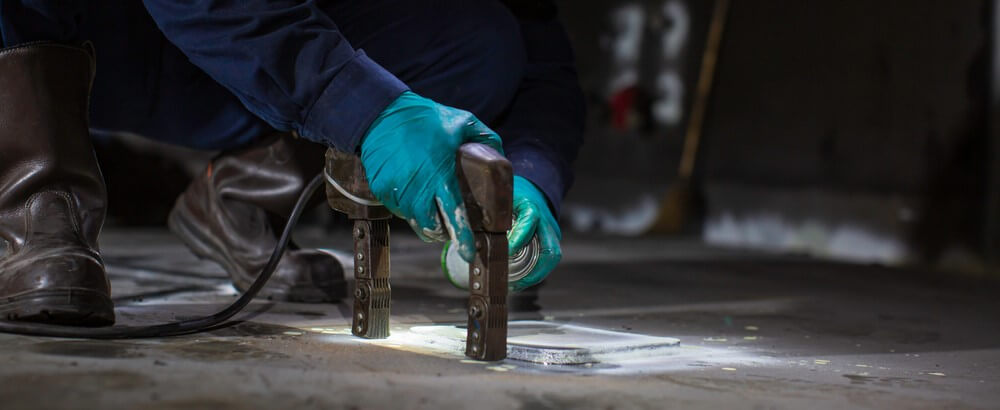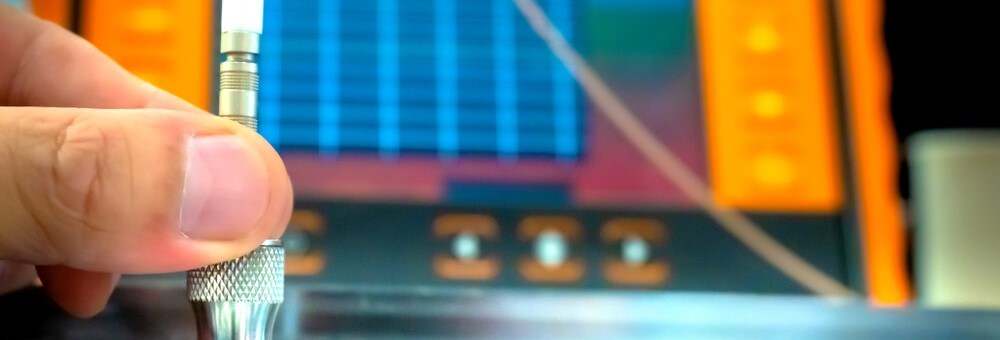What is Non Destructive Testing (NDT)?
Non Destructive Testing or NDT is a broad group of analysis techniques used in the science and technology industry to evaluate the properties of a material, component, or system without causing damage. Because NDT does not permanently alter the article being inspected, it is a highly valuable technique that saves money and time in product evaluation, troubleshooting, and research.
Common NDT methods include:
The terms Non-Destructive Examination (NDE), Non-Destructive Inspection (NDI), and Non-Destructive Evaluation (NDE) are also commonly used to describe this technology. NDT is widely used in forensic engineering, mechanical engineering, petroleum engineering, electrical engineering, aeronautical engineering, and medicine.
- Non Destructive Testing is the process of inspecting, testing, or evaluating materials, components, or assemblies for discontinuities or differences in characteristics without destroying the serviceability of the part or system.
- NDT tests do not change the structural properties of the material.
- Safety norms can be applied after the requirements of the test.
Quick Navigation
What is Non-Destructive Testing of Concrete?
Non Destructive Test (NDT) of concrete is performed to obtain/assess the various properties of concrete of existing structures without damaging or destroying them. This test provides simple, immediate results and actual strengths and properties of the concrete structure. In the NDT method, without loading the specimen to failure (i.e., without destructing the concrete), we can measure the strength of the concrete. This testing method also helps us investigate crack depth, micro-cracks, and concrete deterioration.

Uses of Non Destructive Test (NDT) of Concrete
- Estimating the on-site compressive strength.
- Confirming the quality of the standard requirement.
- Monitoring of strength development.
- Detection of cracks, voids, or any other similar defects.
- Determine the extent of corrosion.
- Monitoring changes in the structure of the concrete may occur with time. Evaluate Chloride, sulfate, alkali contents, or carbonation content.
- Evaluate the probable durability of concrete.
What are the Types of Non-Destructive Testing (NDT)?
Many different Non-Destructive Testing (NDT) methods are available in the industry, each with advantages and limitations, but six are most frequently used.
1. Radiography Testing
Radiography Testing involves penetrating X or gamma radiation as sources to examine parts and products for imperfections.
Advantages of Radiography Testing are:
- It can be used to inspect virtually all materials.
- High accuracy in locating defects, irregularities, or flaws.
- Ability to inspect complex shapes and multi-layered structures without disassembly.
- Minor defects can also be found.
- Provides permanent record.
- Works well on thin samples.
2. Ultrasonic Testing
Ultrasonic Testing uses the transmission of high-frequency sound waves into a material to detect imperfections within the material or changes in material properties. The most commonly used ultrasonic testing technique is pulse-echo Testing. Wherein sound is introduced into the test object, reflections (echoes) are returned to a receiver from the part’s internal imperfections or geometrical surfaces.

Advantages of Ultrasonic Testing are:
- Highly Reliable
- Low cost
- Easy to Operate
- Minute defects can also be detected
- It can be used for a specimen of any size, thickness, and shape
- Very useful only when one side of the sample is accessible
- Location of the depth of defect can be located
- No special safety precautions are needed.
3. Acoustic Emission Testing
Acoustic Emission Testing (AE) is a non-destructive testing (NDT) technique used for detecting damages, cracks, and leaks in different structures such as metals, composites, wood, fiberglass, ceramics, and plastics. Etc.
Acoustic Emission Testing (AE) is a very effective non-destructive technique that identifies micro and macro defects and their temporal evolution in several materials. This technique permits the estimation of the velocity of ultrasound wave propagation and the amount of energy released during fracture propagation to obtain information on the criticality of the ongoing process.
- Acoustic Emission (AE)is a study and practical use of elastic waves generated by a material subjected to external stress.
- Acoustic Emission (AE) has been used on pressure vessels, fire bottles, wind turbines, gas wells, nuclear weapons, and solar collectors.
Advantages of Acoustic Emission Testing (AE)
- Real-time detection of component failure.
- Highly accurate results.
- Sensitive
- Economical
- Early Warning of crack growth
- The exact location of the defect can be found
- Possible to test pressure equipment during plant operation.
What are the Objectives of the Non-Destructive Testing?
Non Destructive Testing methods are routinely applied in industries where a component’s failure would cause significant hazards or economic loss, such as in transportation, pressure vessels, building structures, piping, and hoisting equipment (crane). The objectives of non-destructive testing are:
- To ensure product reliability.
- To prevent accidents.
- To control the manufacturing process and lower manufacturing costs.
- To maintain a uniform quality level.
- To prevent unexpected failure.
- Very useful to locate the defects or flaws in the components.
- To monitor the conditions of process equipment.
What are the Advantages of Non-Destructive Testing (NDT)?
Non Destructive Testing is the ability to examine a material (usually for discontinuities) without impairing it. The advantages of Non-Destructive Testing are:
- Increases the safety and reliability of the product during operation.
- Decreases the cost of the product by reducing scrap and conserving materials, labor, and energy.
- Enhances the reputation of the manufacturer as a producer of quality goods.
- All of the above factors boost the product’s sales, bringing the manufacturer more economic benefits.
- Used widely for routine or periodic determination of the quality of the plants and structures during service.
- Eliminates force to shut down the plants.

Why Choose Us?
We offer you the most effective NDT methods to investigate the integrity of your equipment and assets. Our comprehensive range of NDT methods can help you:
- Save time and money through fast and practical testing of your assets and equipment at every stage of their lifespan – from manufacturing to on-site operation.
- Monitor the integrity of your assets using intrusive or non-intrusive methods.
- Ensure safe and reliable operation of your facilities.
- Detect defects and irregularities before they result in severe damage or non-compliance.
TUV Austria Bureau of Inspection & Certification’s vast umbrella of inspection services includes:
- Third Party Inspection Services
- Pre-Shipment Inspection Services
- Risk-Based Inspection Services
- Crane Inspection Services
- Lifting Equipment Inspection Services
- QA / QC Services
- Construction Supervision Services
- Technical Manpower Supply Services
- Storage Tank Inspection Services
- Pressure Equipment Directive (PED)
- Pressure Vessel Inspection Services
FAQS
What is Destructive Testing?
In Destructive Testing, tests are carried out to understand a specimen’s performance or material behavior under different loads.
- Destructive Testing is most suitable and economical for objects which will be mass-produced, as the cost of destroying a small number of specimens is negligible.
- It is usually not economical to do destructive Testing where only one or few items are to be produced (for example, in the case of a building).
What are Non-Destructive Testing Methods?
NDT stands for Non-Destructive Testing. It refers to an array of inspection methods that allow inspectors to evaluate and collect data about a material, system, or component without permanently altering it. The Non Destructive Testing Methods are:
- Visual Inspection
- Radiography
- Ultrasonic
- Eddy Current
- Magnetic Particle
- Liquid Penetrant
- Tap Testing
- Microwave
- Acoustic Emission
- Thermography
- Acoustic Microscopy
- Flux Leakage
- Magnetic Measurements
- Replication
- Laser Interferometry.
What are the Different Names of NDT?
NDT: Non-Destructive Testing.
NDI: Non-Destructive Inspection.
NDE: Non-Destructive Evaluation.
NDE: Non-Destructive Evaluation.
In Which Fields NDT Methods Used?
It is widely used in fields like
- Mechanical Engineering.
- Electrical Engineering.
- Civil Engineering.
- Aerospace Engineering.
Where are NDT methods Used?
- It is used in all the stages, like in a component’s production or life cycle.
- To assist in product development.
- To Screen or Sort Incoming Materials.
- To monitor, improve or control manufacturing processes.
- To verify proper processing such as heat treating.
- To verify proper assembly.
- To inspect for in-service damage.
What are some uses of NDT Methods?
- Flaw detection and Evaluation.
- Leak Detection.
- Location Determination.
- Dimensional Measurements.
- Structure and Microstructure Characterization.
- Estimation of Mechanical and Physical Properties.
- Stress and Dynamic Response Measurements.
- Material Sorting and chemical composition Determination.
What are Advanced NDT methods?
- Many plant operators in the oil, gas, and power generation industries face the challenges of maximizing the integrity of the plant.
- Our highly skilled teams constantly endeavor to develop innovative and superior solutions for all its customers.
- The efficiency and life expectancy of their assets without sacrificing safety and reliability.
Therefore, ensuring accurate inspection of vital components such as pipes and tubes is crucial.